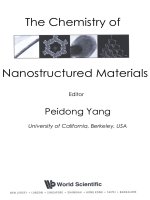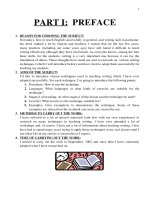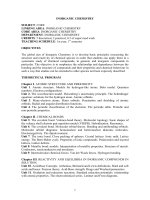Classroom chemistry
Bạn đang xem bản rút gọn của tài liệu. Xem và tải ngay bản đầy đủ của tài liệu tại đây (1.29 MB, 35 trang )
Classroom Chemistry
Grade 5 Science
Mr. Larson
Student Learner Expectations
Safety Rules
Do not let chemicals come in contact with
your skin
Rinse well, if you do get chemicals on
yourself.
Wipe up spills immediately.
Wash your hands with soap
Never taste chemicals.
Waft, when smelling.
Matter
Matter is the substance of which physical
objects are composed.
It can be solid, liquid or gas.
Solids
Molecules are
attached and bunched
together in a “solid”
form.
Doesn’t change
shape easily.
Another solid cannot
pass through easily
Liquid
Molecules fill the
space of the container
they are in.
They can shape
easily.
A solid can pass
through it.
Gas
Molecules freely
move around. They
are not closely bound
together.
Changes shape easily
A solid can pass
through it easily.
Changes of State
Solid to Liquid- Melting
Liquid to Solid- Freezing
Liquid to Gas- Evaporation
Gas to Liquid- Condensation
Mixtures
Matter can generally be mixed with other
types of matter.
A mixture is when particles of one
substance mixes with particles of another
substance. They are generally pure
substances.
Where do we see mixtures?
Brainstorm as a small group.
Examples: recipes, construction-concrete,
water, lemonade, salad dressings.
BLM #1
Separating Mixtures
How can you separate substances from a
mixture?
BLM #2
Methods of Separating: sieves, magnets,
air, water, evaporation, distilling, filtering
Separating Mixtures
In groups, complete BLM #2
See if you can separate the mixture you
are given.
Methods of Separating
Sieves: can be used
to separate solids.
Magnets: can pick
magnetic objects,
from non-magnetic.
Methods of Separating
Air: you can blow
away lighter
substances, to leave
heavier ones.
Water: some
substances will float
or sink based on their
buoyancy.
Methods of Separating
Evaporation:
evaporate the liquid
and leave the solid.
Distilling: the
processing of
vaporizing into gas
and then condensing
back into a liquid
Methods of Separating
Filtration: using a filter and pouring the
liquid through to separate the solid.
/>ages/10_11/rev_irrev_changes.shtml
Mixing Liquids
BLM #3 and #4
Some liquids mix completely and are
unable to be separated. eg: Milk and Tea
Some liquids do not dissolve in others and
are more buoyant. eg: oil and water
Some liquids are heavier, less buoyant
and settle on the bottom. eg: syrup
Mixing Liquids
Some liquids react to each other. Eg:
vinegar and milk.
Some liquids are able to dissolve solids,
while some are not.
Lemonade is an example of a liquid
mixture.
Activity: Layering Liquids
Why were the liquids able to be layered
and not mixed?
Try mixing two different liquids, record
your observations.
Lifesaver Experiment
BLM #6 and 7
Observe how long the lifesaver takes to dissolve
The lifesaver dissolved into the water
Dissolve is when a solid crumbles into a liquid.
Can you make it dissolve faster?
Lifesaver Experiment: Inferences
Manipulated Variable Responding Variable- amount of time it will
take to dissolve a lifesaver.
Solutions
A homogeneous mixture in which the
solute is uniformly distributed throughout
the solvent.
Solute- The substance that is being
dissolved in a solution.
Solvent- the substance that does the
dissolving in a solution
Suspension
A mixture in which very small particles of a
solid remain suspended without dissolving.
Heterogeneous Mixture- when one
substance is unevenly mixed with another.
Separating Solutions
Filtering
Pouring off the liquid
Evaporation
Solution to Recovery Activity









